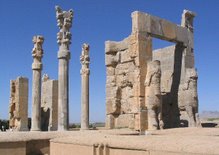 The current and official flag of Iran was designed andadopted on July 29, 1980, after the Iranian Revolutionof 1979. Its emblem is shaped to represent the nameof Allah. The symbol consists of four crescents and asword. The four crescents are meant to stand for theword "Allah." The five parts of the emblem symbolize thefive pillars of Islam. Above the sword (central part) is a "tashdid" (looks a bit like a W). In Arabic writing this is used to double a letter, here it doubles the strength of the sword.The shape of the emblem is chosen to represent atulip, for the memory of the (young) people who diedfor Iran. It is an ancient belief in Iran, dating back to mythology, that if a young soldier dies patriotically, a red tulip will grow on his grave. In recent years it is considered as the symbol of martyrdom.The words of "Allah-O-Akbar" (God is Great) are alsoshown on the center-border of green and red color 22times. According to the constitution of the IslamicRepublic of Iran, number 22 was chosen because theIranian Revolution overthrew the previous regime onthe 22nd of the 11th month of the Iranian calendar.The Iranian calendar is based on Zodiac signs. The year begins in March 21st and the 11th month coincidesexactly with Aquarius. So we have 11 green copies onthe top and 11 red copies on the bottom of the whitestrip.The green represents Islam, the white for peace, andthe red for courage.For many Iranians, this is not the official Iranian flag and they still adhere to the pre-revolutionary flag that pre-dates centuries ago.
The current and official flag of Iran was designed andadopted on July 29, 1980, after the Iranian Revolutionof 1979. Its emblem is shaped to represent the nameof Allah. The symbol consists of four crescents and asword. The four crescents are meant to stand for theword "Allah." The five parts of the emblem symbolize thefive pillars of Islam. Above the sword (central part) is a "tashdid" (looks a bit like a W). In Arabic writing this is used to double a letter, here it doubles the strength of the sword.The shape of the emblem is chosen to represent atulip, for the memory of the (young) people who diedfor Iran. It is an ancient belief in Iran, dating back to mythology, that if a young soldier dies patriotically, a red tulip will grow on his grave. In recent years it is considered as the symbol of martyrdom.The words of "Allah-O-Akbar" (God is Great) are alsoshown on the center-border of green and red color 22times. According to the constitution of the IslamicRepublic of Iran, number 22 was chosen because theIranian Revolution overthrew the previous regime onthe 22nd of the 11th month of the Iranian calendar.The Iranian calendar is based on Zodiac signs. The year begins in March 21st and the 11th month coincidesexactly with Aquarius. So we have 11 green copies onthe top and 11 red copies on the bottom of the whitestrip.The green represents Islam, the white for peace, andthe red for courage.For many Iranians, this is not the official Iranian flag and they still adhere to the pre-revolutionary flag that pre-dates centuries ago.The Shir-o-Khorshid (Lion and Sun) Iranian flag is thebest-known symbol of Iran in recent centuries. Thelion and sun motif, which is probably a graphicexpression of the astrological configuration of thesun in the sign of Leo, although both celestial andanimal figures independently have a long history inIranian heraldry. The lion and sun emblem is veryancient, and Ferdowsi the epic poet writes that it wasused by Rostam, the legendary national hero. Late inthe nineteenth century an earlier scimitar motif wascombined with the lion and sun and superimposed on atricolor of green, white and red, and, with minormodifications, this remained the official flag untilthe revolution of 1979.It is difficult to get precise historical data regarding the Lion and Sun flag because it dates back centuries. Often is the case that when comparing different available information pertaining to the Lion and Sun flag, you find many inconsistencies.
Although many Iranians see this flag as their historic flag. It too is surrounded with controversy as it has come to be associated with different political figures and groups who raise this same flag. In other words, the Iranian flag is a hotly contested issue. Unfortunately, it has become increasingly difficult for an Iranian who simply wants to wave a flag to show their connection to the land of Iran without being accused of adhering to controversial politics.
Although many Iranians see this flag as their historic flag. It too is surrounded with controversy as it has come to be associated with different political figures and groups who raise this same flag. In other words, the Iranian flag is a hotly contested issue. Unfortunately, it has become increasingly difficult for an Iranian who simply wants to wave a flag to show their connection to the land of Iran without being accused of adhering to controversial politics.






No comments:
Post a Comment